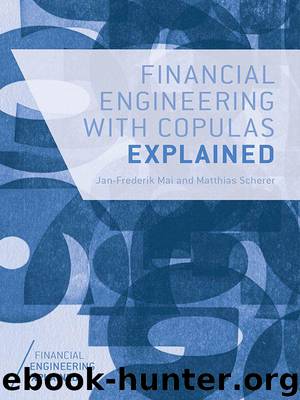Financial Engineering with Copulas Explained (Financial Engineering Explained) by Mai Jan-Frederik & Scherer Matthias

Author:Mai, Jan-Frederik & Scherer, Matthias [Mai, Jan-Frederik]
Language: eng
Format: epub
ISBN: 9781137346322
Publisher: Palgrave Macmillan
Published: 2014-10-02T23:00:00+00:00
The justification of Algorithm 5.0.3 stems from the strong law of large numbers, which states that for a sequence of independent and identically distributed random variables Z1, Z2, . . . with finite mean it follows almost surely that
Applying this statement to the random variables verifies why Algorithm 5.0.3 makes sense.
FAQ 5.0.4 (What are the pros and cons of the Monte-Carlo method?)
On the one hand, the most obvious drawback of the Monte-Carlo method is that it requires quite a lot of runtime, because one needs to simulate a huge number n of scenarios to create a sufficiently accurate estimate for the desired expectation value. In particular, if one wishes to calibrate the model’s parameters to observed data, then one needs to re-evaluate the expected value in question multiple times for different parameter sets. Another disadvantage is that, depending on the specific problem, the variance of the random variable f (X1, . . . , Xd) in question might be huge. In order to obtain a reasonable confidence interval in such a case, we might require a very high number of samples n. For this reason, it is always important to provide a confidence interval together with a Monte-Carlo estimator, because otherwise one cannot judge its accuracy.
On the other hand, the most striking advantage of the Monte-Carlo method is its applicability to very complex models. It is often the only method feasible, in particular if the dimension d is large. Moreover, provided the variance σ2 of f(X1, . . . , Xd) is finite, the standard deviation of the Monte-Carlo estimate equals times σ, implying that the convergence rate of the Monte-Carlo estimator is known and problem-invariant. Furthermore, applying the central limit theorem, an asymptotic (1 – α)-confidence interval can be computed quite easily by adding and subtracting the value from the Monte-Carlo estimate for the mean, for example for α = 0.05 or α = 0.01. If σ is unknown, which is typically the case, it may simply be replaced with its canonical estimator
Download
This site does not store any files on its server. We only index and link to content provided by other sites. Please contact the content providers to delete copyright contents if any and email us, we'll remove relevant links or contents immediately.
| Analysis & Strategy | Bonds |
| Commodities | Derivatives |
| Futures | Introduction |
| Mutual Funds | Online Trading |
| Options | Portfolio Management |
| Real Estate | Stocks |
Rich Dad Poor Dad by Robert T. Kiyosaki(6414)
Pioneering Portfolio Management by David F. Swensen(6230)
How To Win Friends and Influence People by Dale Carnegie(4447)
The Money Culture by Michael Lewis(4083)
The Dhandho Investor by Mohnish Pabrai(3706)
The Wisdom of Finance by Mihir Desai(3659)
Liar's Poker by Michael Lewis(3372)
Fooled by Randomness: The Hidden Role of Chance in Life and in the Markets by Nassim Nicholas Taleb(3049)
The ONE Thing by Gary Keller(3013)
The Intelligent Investor by Benjamin Graham Jason Zweig(2996)
Mastering Bitcoin: Programming the Open Blockchain by Andreas M. Antonopoulos(2983)
Rich Dad Poor Dad: What The Rich Teach Their Kids About Money - That The Poor And Middle Class Do Not! by Robert T. Kiyosaki(2910)
How to Day Trade for a Living: Tools, Tactics, Money Management, Discipline and Trading Psychology by Andrew Aziz(2909)
Investing For Dummies by Eric Tyson(2895)
How to Win Friends and Influence People by Dale Carnegie(2864)
Market Wizards by Jack D. Schwager(2645)
The Psychology of Money by Morgan Housel(2634)
Zero Hour by Harry S. Dent Jr. & Andrew Pancholi(2614)
How to Pay Zero Taxes, 2018 by Jeff A. Schnepper(2604)
